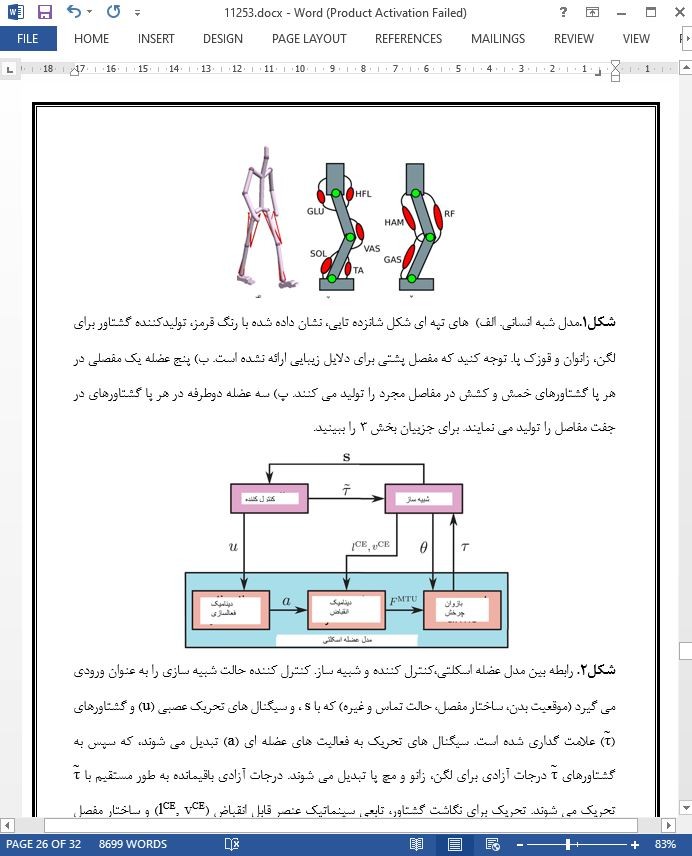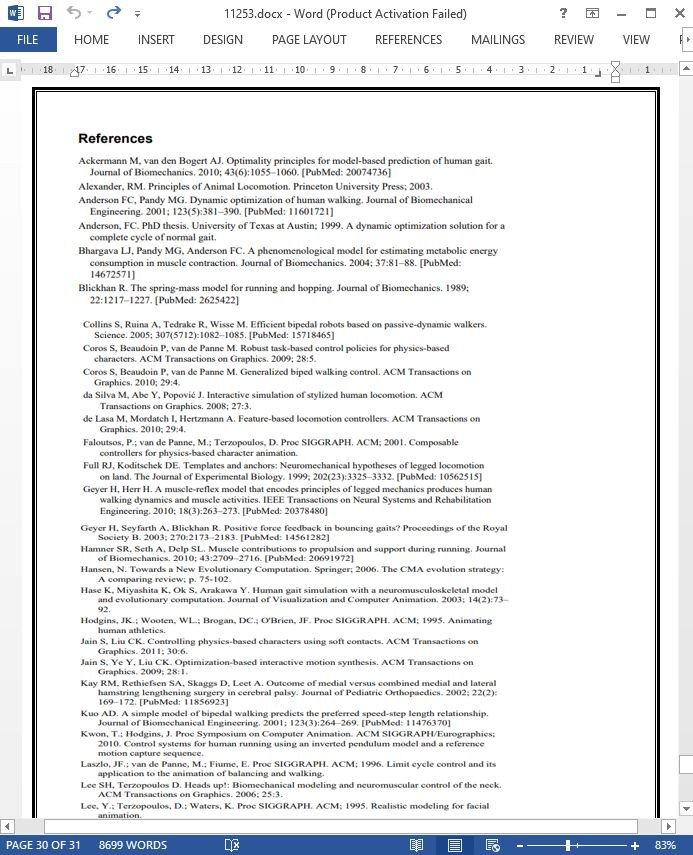
بهینه سازی کنترل کننده های حرکتی با استفاده از محرک ها و هدف های پایه بیولوژیکی
چکیده
ما تکنیکی را برای ترکیب اتوماتیک کنترل کننده های پیاده روی و دویدن برای کاراکترهای شبیه انسانی سه بعدی که به صورت فیزیکی شبیه سازی شده اند ارائه خواهیم کرد. درجات آزادی لگن، زانو و قوزک پا، با استفاده از مجموعه 8تایی از مدل های وترماهیچه ای تپه ای شکل، با قوانین کنترل بیولوژیکی-تحریکی بکار انداخته شده اند. پارامترهای این قوانین کنترلی با یک رویه بهینه سازی که شماری از مولفه های وظیفه حرکتی را پاسخ می دهد، و مدل هزینه انرژی کمینه دارد، انتخاب شده اند. ما اثبات خواهیم کرد که استفاده از محرک ها و هدف های با پایه بیولوژیکی، به طور قابل ملاحظه ای واقعیت قدم های زده شده توسط کنترل کننده های حرکتی را که بدون استفاده از داده کنترل مسیر حرکت عمل می کند، افزایش می دهد و نشان خواهیم داد که هزینه انرژی مصرفی، سنجش ساده و واحدی از تلاشی خواهد بود که برای بهینه سازی کنترل هردو کار قدم زدن و دویدن انجام می شود.
1. معرفی
توسعه کنترل کننده های حرکتی پایه فیزیکی de novo، مستقل از داده حرکتی ذخیره، موضوعی بسیار قدیمی در تحقیقات گرافیک کامپیوتری بوده است، و در سال های اخیر دوباره احیاء شده است. صرف نظر از فرایند موثر، قدم های تولیدی توسط کنترل کننده های موجود از نمود طبیعی حرکت انسانی بسیار متفاوتند. برای مثال، کنترل کننده های پایه فیزیکی که از داده کنترل حرکت بهره نمی برند، به طور متداول حرکت قدم زدن را با پریدن زیاد انجام می دهند که با قوز زیاد و روانی کمتر از قدم زدن انسان عادی است.
7. تشریح مطالب
ما یک پارامتربندی کنترل با تحریک بیولوژیکی ارائه نموده ایم که برای کنترل کننده های دویدن و قدم زدن شبه انسانی سه بعدی با سرعت های مختلف قابل استفاده است. کنترل کننده ها برای اطمینان از مجموعه ای از وظایف سطح بالا حین کمینه کردن ترم تلاش برپایه مدلسازی نرخ مصرف انرژی متابولیک، بهینه شده اند. بطور قابل ملاحظه، دویدن و قدم زدن ظاهر شده از فرایند بهینه سازی مشابه، به سادگی با تغییر سرعت هدف و ارزش دهی آغازی انجام شده اند. درمیان مقایسه های سینماتیک و داده چرخش قدم زدن انسان، ما نشان می دهیم که نتایجمان با یک استراتژی تولید گشتاور شبه انسانی تطابق دارد، در حالی که داده سینماتیک از کارهای قبلی بسیار نزیکتر به انسان است. کار ما اهمیت مدلسازی قیود در تولید گشتاور از فیزیولوژی عضله را، در هردو مورد محدودکردن فضای مسیرهای چرخش احتمالی و ارائه مدل تلاش نمایان می سازد.
Abstract
We present a technique for automatically synthesizing walking and running controllers for physically-simulated 3D humanoid characters. The sagittal hip, knee, and ankle degrees-of-freedom are actuated using a set of eight Hill-type musculotendon models in each leg, with biologically-motivated control laws. The parameters of these control laws are set by an optimization procedure that satisfies a number of locomotion task terms while minimizing a biological model of metabolic energy expenditure. We show that the use of biologically-based actuators and objectives measurably increases the realism of gaits generated by locomotion controllers that operate without the use of motion capture data, and that metabolic energy expenditure provides a simple and unifying measurement of effort that can be used for both walking and running control optimization.
1 Introduction
The development of physics-based locomotion controllers de novo, independent from stock motion data, has been a long-standing objective in computer graphics research and has seen resurgence in recent years. Despite impressive progress, the gaits produced by existing controllers fall short of the natural appearance of human locomotion. For example, physicsbased walking controllers that do not rely on motion capture data commonly produce walking motion with exaggerated hip flexion which appears more crouched and less fluid than typical human walking.
7 Discussion
We have presented a biologically-motivated control parameterization that can be used to automatically generate 3D human-like walking and running controllers of different speeds. Controllers are optimized to satisfy a set of high-level task terms while minimizing an effort term based on modeling the rate of metabolic energy expenditure. Notably, walking and running emerge from the same optimization process simply by changing the target velocity and initialization. Through comparisons to kinematic and torque data of human walking, we show that our results adopt a human-like torque generation strategy while producing kinematic data significantly closer to humans than previous work. Our work demonstrates the importance of modeling constraints on torque generation due to muscle physiology, both in restricting the space of possible torque trajectories and in providing a realistic model of effort.
چکیده
1. معرفی
2 . کار مربوط
3. مدل شبه انسانی
3. 1 . مدل تاندون-عضله ای
4 . پارامتربندی کنترل
4. 1 کنترل عضله
4. 2 . فاز ایستادن
4. 3 . فاز چرخیدن
4. 4 . کنترل خارج از صفحه و بالاتنه
5. بهینه سازی
5 .1 . ترم تلاش
6. آزمایشات
6. 1. داده تصدیقی زمینی
6. 2. کنترل کننده های قدم زدن
6. 3 . کنترل کننده های دویدن
6. 4 . نیرومندی
7. تشریح مطالب
Abstract
1 Introduction
2 Related Work
3 Humanoid Model
3.1 Musculotendon Model
4 Control Parameterization
4.1 Muscle Control
4.2 Stance Phase
4.3 Swing Phase
4.4 Out-of-Plane and Upperbody Control
5 Optimization
5.1 Effort Term
6 Experiments
6.1 Ground Truth Data
6.2 Walking Controllers
6.3 Running Controllers
6.4 Robustness
7 Discussion
- اصل مقاله انگلیسی با فرمت ورد (word) با قابلیت ویرایش
- ترجمه فارسی مقاله با فرمت ورد (word) با قابلیت ویرایش، بدون آرم سایت ای ترجمه
- ترجمه فارسی مقاله با فرمت pdf، بدون آرم سایت ای ترجمه



